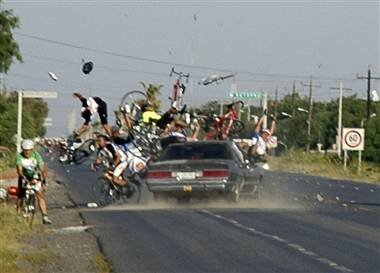NHTSA: Pedestrian and Cyclists Crash Rates Higher For Hybrids
An NHTSA report [ PDF] on the “Incidence of Pedestrian and Bicyclist Crashes by Hybrid Electric Passenger Vehicles,” concludes that hybrid-electrics (HEVs) have a higher incidence rate of pedestrian and bicyclist crashes than do internal combustion-only (ICE) vehicles in certain scenarios. And based on the report’s conclusions, it looks like the relative silence of hybrids running in electric-only mode is to blame for the higher accident numbers.
. . . pedestrian and bicyclist crashes involving both HEVs and ICE vehicles commonly occurred on roadways, in zones with low speed limits, during daytime and in clear weather, with higher incidence rates for HEVs when compared to ICE vehicles. A variety of crash factors were examined to determine the relative incidence rates of HEVs versus ICE vehicles in a range of crash scenarios. For one group of scenarios, those in which a vehicle is slowing or stopping, backing up, or entering or leaving a parking space, a statistically significant effect was found due to engine type. The HEV was two times more likely to be involved in a pedestrian crash in these situations than was an ICE vehicle. Vehicle maneuvers such as slowing or stopping, backing up, or entering or leaving a parking space, were grouped in one category based on that these maneuvers are potentially have occurred at very low speeds where the difference between the sound levels produced by the hybrid versus ICE vehicle is the greatest.
At speeds above 35 MPH, the statistical differences between the percentage of hybrids and ICE vehicles involved in pedestrian and cyclist crashes are insignificant. Below those speeds, and while engaging in the maneuvers described above, the statistical difference becomes clear. What this indicates is that the silence of electric drive vehicles is, statistically speaking, a safety issue. Expect this study to figure into ongoing efforts to pass legislation, like H.R. 734, requiring sound standards for electric-drive vehicles.
More by Edward Niedermeyer
Latest Car Reviews
Read moreLatest Product Reviews
Read moreRecent Comments
- Lou_BC Hard pass
- TheEndlessEnigma These cars were bought and hooned. This is a bomb waiting to go off in an owner's driveway.
- Kwik_Shift_Pro4X Thankfully I don't have to deal with GDI issues in my Frontier. These cleaners should do well for me if I win.
- Theflyersfan Serious answer time...Honda used to stand for excellence in auto engineering. Their first main claim to fame was the CVCC (we don't need a catalytic converter!) engine and it sent from there. Their suspensions, their VTEC engines, slick manual transmissions, even a stowing minivan seat, all theirs. But I think they've been coasting a bit lately. Yes, the Civic Type-R has a powerful small engine, but the Honda of old would have found a way to get more revs out of it and make it feel like an i-VTEC engine of old instead of any old turbo engine that can be found in a multitude of performance small cars. Their 1.5L turbo-4...well...have they ever figured out the oil dilution problems? Very un-Honda-like. Paint issues that still linger. Cheaper feeling interior trim. All things that fly in the face of what Honda once was. The only thing that they seem to have kept have been the sales staff that treat you with utter contempt for daring to walk into their inner sanctum and wanting a deal on something that isn't a bare-bones CR-V. So Honda, beat the rest of your Japanese and Korean rivals, and plug-in hybridize everything. If you want a relatively (in an engineering way) easy way to get ahead of the curve, raise the CAFE score, and have a major point to advertise, and be able to sell to those who can't plug in easily, sell them on something that will get, for example, 35% better mileage, plug in when you get a chance, and drives like a Honda. Bring back some of the engineering skills that Honda once stood for. And then start introducing a portfolio of EVs once people are more comfortable with the idea of plugging in. People seeing that they can easily use an EV for their daily errands with the gas engine never starting will eventually sell them on a future EV because that range anxiety will be lessened. The all EV leap is still a bridge too far, especially as recent sales numbers have shown. Baby steps. That's how you win people over.
- Theflyersfan If this saves (or delays) an expensive carbon brushing off of the valves down the road, I'll take a case. I understand that can be a very expensive bit of scheduled maintenance.

































Comments
Join the conversation
BomberPete, I apologize if it seemed I was implying it was the cyclists' fault for not riding single file in this picture. The pic was posted without context, that being a race and a drunk driver. I really was commenting on bikers in general, being one myself. They/I/we often contribute to accidents by riding all over the road carelessly. This does not absolve a careless and/or illegal driver, but it shows there are things we can do to protect ourselves from these people. Spanner77, you are right that holding drivers accountable for all accidents is unjust. However, like or not, public roads in the U.S. (not including freeways) are generally "shared space" according to the law. (To label it socialism is to demonstrate you do not understand socialism.) However, the wise cyclist picks his routes well to avoid the danger of high speed cars.
Even some ICE cars are so quiet they are sonically invisible until the idiot driving decides to pass on a blind turn while leaving no space between his fender and me.